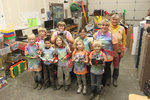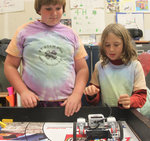Ella Ashford is one of the leading engineers in her field.
Ella, 14, is president of the 4-H PT STEM Club, a robotics team that is now preparing for the 2015 FIRST Lego League (FLL) robotics …
This item is available in full to subscribers.
We have recently launched a new and improved website. To continue reading, you will need to either log into your subscriber account, or purchase a new subscription.
If you had an active account on our previous website, then you have an account here. Simply reset your password to regain access to your account.
If you did not have an account on our previous website, but are a current print subscriber, click here to set up your website account.
Otherwise, click here to view your options for subscribing.
* Having trouble? Call our circulation department at 360-385-2900, or email our support.
Please log in to continue |
|



Ella Ashford is one of the leading engineers in her field.
Ella, 14, is president of the 4-H PT STEM Club, a robotics team that is now preparing for the 2015 FIRST Lego League (FLL) robotics competition.
These students are not playing with Legos. They're involved in robotics – designing, engineering and programming innovative machines to perform specific tasks.
A friendly and cheerful person, Ella is putting her intelligence and energy to work trying to solve the world's problems.
FLL teams also help their communities. Because this year’s FLL theme, "Trash Trek," is about garbage, the 4-H PT STEM Club started a pumpkin-related "trash trek."
Club members discovered that 1 billion pounds of pumpkins are grown each year and often end up in landfills rather than being composted (because of wax left from use as jack-o'-lanterns). So they began a project to keep pumpkins out of trash cans, partnering with the PT Food Co-op to establish a community pumpkin compost area and staging a catapult pumpkin toss at the Jefferson County Fairgrounds to raise awareness. They're also designing a "degunker," a robot that removes the seeds and "gunk" inside pumpkins, because those unwanted pumpkin seeds are another reason the gourds aren't composted.
Meanwhile, Ella and her team are busy with robot design. They work in a lab (her mom's garage), where they also help the Junior FLL kids, who are in kindergarten through middle school, learn to build, design and program robots. A key lesson is that engineering includes trying things out, building faulty robots and starting over again.
“‘I did not fail; I found 10,000 ways that did not work,’” says Ella, quoting Thomas Edison.
Ella and her team, as well as other FLL teams from all over the world, will soon head to regional FLL competitions, setting up Lego-based robots to do the same set of tasks. FIRST, which stands for "For Inspiration and Recognition of Science and Technology," is an international organization, with more than 233,000 participants in the U.S. alone. The 4-H PT STEM Club team, named the Dueling Dragons, is currently ranked 18th in Washington state in FLL. High school robotics teams, including the local Roboctopi, which made it to the world championships last year, are also overseen by FIRST.
CHALLENGE TABLE
Ella's mom, Gabriella (Gabby) Ashford, lets the club use her garage, and it's a hive of activity. Bins and boxes of robot parts fill the space under a workbench lined with computer monitors. On a patch of clear floor, kids are busy building, testing, rebuilding and retesting remote-controlled Lego robots.
Another club member builds a robot at a cluttered table, carefully following design instructions in a book; another works at a computer; building a robot for an FLL competition includes programming as well as design – the robots must be preprogrammed and autonomous in the competition.
The center of the action is the FLL challenge table, basically a piece of plywood with a low wall around it made of 2-by-4 lumber. The table, built to FIRST specifications, is topped with a printed mat, called a "field map," that was included in the standardized kit sent to all the teams.
"We build this board, and they send the field map," Ella says. The field map includes black lines that can be read by sensors on the robot. A quarter-circle in one corner is "base" – that's where the robot is placed to start the competition. From base, the robot must move around the challenge table and complete a series of "around 20" missions, or obstacles, within two and a half minutes.
The missions are tasks done by the robot's armatures, such as moving objects from one place to another, turning a wheel or pressing a lever. Team members may only touch their robots when they're in the "base" corner; they have to have programmed them correctly beforehand – but robots can return to base to change armatures.
Some of the missions in this year's Trash Trek, such as "Demolition" and "Factory," create "waste products." Some black pieces represent "trash"; blue and yellow are "recyclables." One of the missions involves a sorter, which has a wheel the robot must turn. Another corner on the table is designated as the "landfill."
"All this comes in a big box," Ella explains. Kits include a printed mat for the challenge table and all necessary Lego parts, wheels and electronics, plus parts and instructions for building the standardized "mission" structures for the team's home table.
'COOPERATITION'
After designing robots and testing them on challenge tables in their home labs, the teams bring their completed robots to the competition, along with several possible programming options to be chosen on the spot.
"You talk to the other team about if they want to do the 'cooperatition,'" Ella says – an alternative to direct competition that is a combination of cooperation and competition. In the case of the Trash Trek, cooperatition may include "selling" bins of "recyclables" to the other team. "You run a different program depending on their answer," Ella says.
Robots' performances are also judged on other factors besides completing tasks, as are the teams. "It could solve all these obstacles, and it still won't be the best robot," says Ella.
She watches her brother Nathaniel test a robot on the challenge table.
"We're probably going to scrimmage the robots to see which one does best," she says. This is Ella's fourth year on the team, and Nathaniel's third.
Teams also bring information-display boards for sharing what they did with other teams at the competition, a research binder and an engineering binder, thick with digital-design drawings of their robot.
"It's basically Lego CAD [computer-aided design]," Ella says.
Robots must be autonomous, so students have to program them using a computer. "Programming is a lot simpler than it seems," she says. The program goes through a USB cable into the “brain” of the robot. "You tell it what to do." Sensor blocks allow the robot to sense and respond to colors on the field map or other input.
"I've done some real programming. It's called 'C.' It's basically what runs everything – cars, computers. This is a step down. It's a lot simpler. But it helps you understand programming," Ella says.
The younger kids use a simpler program on the computer, she added. "They watch a little video ... follow basic programming, and then they build something to help them understand gears [for example]."
KIDS TEACHING KIDS
Mom Gabby jokes that she doesn't even know how to turn the robots on. "I have the general idea, and if I sat down, I could probably figure it out." Her role is to facilitate, support and organize. "I'm the organization machine," she says. "This is kid-led education, where the kids are teaching each other ... the kids are teaching the kids."
Gabby says three kids who have gone through her 4-H robotics program went on to join the high school team. She says about 20 kids each year take part in the program, "and they're never quite the same after.... Those kids have jobs before they've even graduated from high school, because they've been programming, and engineering, and failing." Learning, in other words.
Ella has been granted a scholarship by the Jefferson County Economic Development Council to take a business class. "She's writing the business plan for the maker space," Gabby says.
That "maker space" is a 4,000-square-foot community lab to be open to the public, and it recently garnered some support from the Port Townsend Elks Club.
"The [robotics] program is growing, and our volunteer force is growing, too," Gabby says, emphasizing the need for collaboration, sharing and community support, rather than a "proprietary" approach. She gestures around her 600-square-foot garage, a bit threadbare, neat but crowded with eight kids working on developing and testing robots. "We've nearly outgrown this space, and are trying to move the whole project into a 4,000-foot space," she says. She mentions the "maker community" being developed at Fort Worden. "It's going to be very high-end," she says, "but this is where the action is."
FIRST robotics has helped hundreds of thousands of kids, Gabby says, "to think about how to solve problems fast," giving them six weeks, three months or six months to solve difficult and complex tasks. This is important for the world's future, she says. "These kids have to learn how to solve problems faster than our generation."
DRAGONFLY WINGS
FLL teams also prepare large information boards displaying their research and engineering, and another showing how they fulfill the FLL "core values," such as "what you discovered as a team, how you integrate it into the community," Ella says.
The 4-H PT STEM Club last year won two "Gracious Professionalism" awards, which is the top Core Values award, Ella says. "It's not just robotics; there's team building," Gabby says. "Four-H spends a lot of time getting the ethics in ... a lot of really good values." That's one reason kids don't "walk off with the parts," she says. "The kids realize that if they take the parts, they're undoing their own success."
One of the team's volunteer mentors teaches the kids a teamwork game called "Adventures." Another talked to them about his work as an engineer on a nuclear submarine.
"We have a huge network of mentors," Ella says. Another mentor taught the kids how to solder, even the youngest ones, and they each made a set of wearable dragonfly wings that fit like little backpacks with broad, gauzy red wings that light up. "We made little boards and circuits and connected the wires to the LED lights," Ella explains, turning over a pair of wings and showing where the circuit board is.
Nearby, some younger kids are testing a new design, learning that it's going to need heavier axles. Another operates a 3-foot-long, remote-controlled, snake-shaped robot on wheels, whose mouth opens and closes, and whose eyes light up red.
"The girls and TJ [Brass, a male team member] are working on a We Do Engineering training project," Gabby says. "They build 12 different things. They are learning all the fundamentals of engineering.... They will graduate to the challenge table."
With help from local kinetic master Charlie Bodony, Ella also designed and built a kinetic sculpture that she pilots in local races. She knows how to weld. Another of Ella's mentors is Marilyn Kurka of the Great Port Townsend Bay Kinetic Skulpture Race. "What we do in kinetic sculptures is deeply embedded" in STEM education, Gabby says. STEM, which stands for science, engineering, technology and math, is a trending focus in American education; many innovative educators also add an A for arts, turning “STEM” into “STEAM.”
Next year, Ella plans to join the local high school robotics team, Roboctopi, which last year went to the FIRST Robotics Competition (FRC) world championships. FRC is the big time – not Lego-based. "They build real robots," she says with a gleam in her eye. "It can be 6 feet tall. They use real motors."